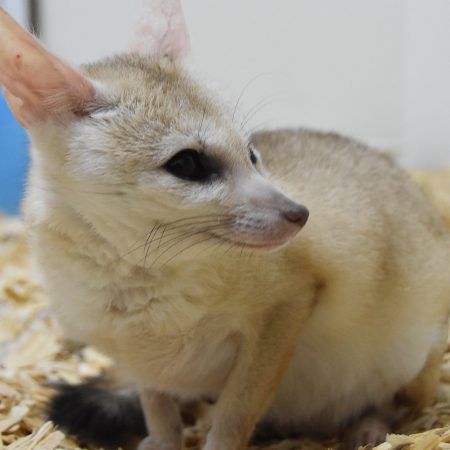Pale Fox
Vulpes pallida
The Pale Fox is one of the least studied of all the Canid species, in part due to its remote habitat. The Pale Fox, also called the Pallid Fox or African Sand fox inhabits the band of African Sahel from Denegal in the west to Sudan in the east. It’s fur coloration is typically a sandy pale, as the name suggests, this helps them blend in with its desert habitat. The Pale fox can be categorized into five subspecies, all of them can interbreed, but live in their own geographical pockets of Africa, making it more challenging. Between the different subspecies, they have slightly different ear coloration and shape.
The pale fox is a small, short-legged, whiskered fox with extremely large ears in comparison to its head. Its large ears are used to detect prey beneath the surface and help regulate its body temperature. The body color varies from a dark sandy brown to a more pale grey. The tips of their tails are called brushes, which are often much darker than the rest of the body. Its body length measures about 1.5 feet long, weighing between 3 to 8 pounds.The pale fox has large eyes in comparison to the rest of its head, they eyes are often ringed in dark brown or black. Since this fox is nocturnal, its large eyes serve a purpose in hunting, being able to capture the most miniscule points of light.

The Pale Fox species is found band of African Sahel, from Senegal in the west to Sudan in the east.
HABITAT -They inhabit the sandy desert plains of central Africa.
DIET -Their diet consists of insects, small rodents and lizards, eggs, small birds, and fruit.
FUN FACT -This is one of the least studied of the entire Canid species.
SOCIAL BEHAVIOR -It’s unclear how they choose a mate, but will live in burrows with up to 6 babies.
ACTIVITY -They are nocturnal, being active during the evening and sleeping during the day.
PREDATORS -Preditors include jackals, large birds of prey, and humans.
SIZE -They are between 1.5 feet long, weighing between 3 to 8 pounds.
RELATIVES -There are 5 subspecies of the Pale Fox, Pallida: Pallida, Cyrenaica, Edwardsi, Harteri, Oertzeni.
CONSERVATION -Pale Foxes are categorized as LC (Least Concern) species by the IUCN.
Cub Creek Animal Care Information
Housing - Our Pale Fox lives in a large, temperature controlled, indoor, enclosure. Pale foxes are good climbers, being able to go up and down steps, as well as use ramps. Tree branches, ramps, and platforms within the enclosure give him space to climb and play. . The indoor portion of the enclosure is bedded with shavings.
Diet - Our Pale Fox enjoys a varied diet of fruits, vegetables, insects, eggs, small rodents, and high quality dog food. This balanced diet gives him all the nutrition he needs, simulating what he eat in the wild. He also enjoys special treats of different kinds of invertebrates and fruits to supplement his diet and provide enrichment.
Enrichment - Our fox are as loveable and playful as your average domesticated dog. He LOVES to play with his squeakers and rope toys. During the summer, campers will make special enrichment toys for him, using plushes, wood, cardboard, and premade pet toys; long with spending time socializing with him to keep him stimulated and happy!


